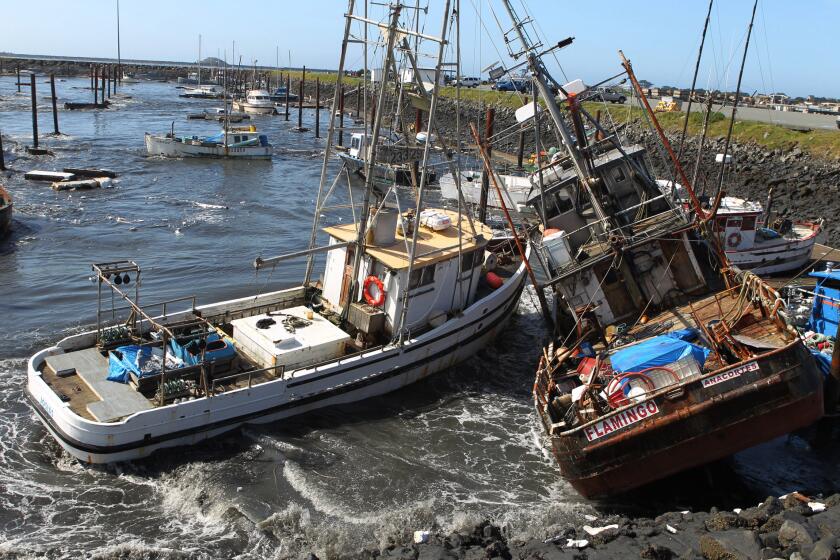Colorado Site Is Nerve Center for Monitoring Earthquakes of Any Size : Seismology: National Earthquake Information Center distributes quake data as quickly as possible ‘to prevent a disaster and save lives.’
- Share via
GOLDEN, Colo. — When the ground began shaking in California, the phones at the U.S. Geological Survey’s National Earthquake Information Center started ringing. And they didn’t stop for eight straight hours.
The NEIC is the nerve center of a computerized nationwide network of seismological sensors that record even the faintest seismic activity--including trucks rumbling over rough roads and small mine blasts.
“We locate all the significant earthquakes around the world and distribute information about them as quickly as we can to people who have the ability to prevent a disaster and save lives,” said Waverly Person, the center’s operations manager and the jovial, graying man who routinely appears on network television when big quakes hit.
When the 6.8-magnitude Northridge earthquake struck on Jan. 17, Person was awakened by his pager shortly after 5:30 a.m. Information relayed to his pager indicated a major tremor that had caused extensive damage. Before he could leave his house, “Good Morning America” called and asked what he knew.
“That’s not unusual,” Persons said. “People often call us and ask for information before the shock waves (which travel at the speed of sound) reach us.”
Person arrived at the center about 6 a.m. and spent the next seven hours in the control room, giving interview after interview and update after update.
“I started the day at 6:10 a.m. and went home at 2 o’clock the next morning,” he said. “And I was back by 5 a.m. because they wanted me to go live on the ‘Today’ show.”
Asked about the big 5.3 aftershock in California in late March, Person said, “People were very, very excited and it frightened a lot of people. It did cause some significant damage, but I think the main effect was it scared people.
“Many scientists expected that an aftershock of that magnitude could occur. But many of the people in California felt that since they had gone so long without getting an aftershock, it wasn’t going to happen again.”
Person, 60, says he is no celebrity, but he does consider himself a pioneer and role model.
“I’m more or less a pioneer as an African-American in this field,” he said. “There may have been one or two before me, but I’m the first I know to come this far. I get more requests for interviews than I can handle, most from predominantly black magazines who are looking for role models.”
The National Earthquake Information Center was founded by the U.S. Department of Commerce in 1966 and was based in Rockville, Md. The center moved to the National Oceanic and Atmospheric Administration facility in Boulder, Colo., in 1972. After the center was moved to the U.S. Department of the Interior, it relocated to the Colorado School of Mines campus in 1973.
Gathering earthquake information in those early years was difficult because there were few seismic sensors to provide data. Technological advances have made the task simpler.
A bank of computers in the center’s basement constantly monitors a network of 130 seismic sensors across the country, automatically issuing a detailed report on every seismological incident that might be interpreted as an earthquake.
The report includes information on the earthquake’s date, time and location; its magnitude, epicenter and proximity to key population centers, and a list of local emergency preparedness officials to contact and their phone numbers.
The system also automatically rings up pagers worn by every center employee and by certain local officials--such as railroad routing centers and dam maintenance and monitoring officials.
“In 1992 we located 19,540 earthquakes worldwide, between 1 and 8 on the Richter scale,” Person said. “In 1993, we’re going to have more--about 20,000. That’s not because our technology is getting better at detecting them.” Last year, there were just more earthquakes.
The Richter scale is a measure of ground motion as recorded on seismographs. Every increase of one number means a tenfold increase in magnitude. Thus, a reading of 7.5 reflects an earthquake 10 times stronger than one of 6.5.
When an earthquake hits, the center’s 22-person staff swings into action, alerting the proper authorities, verifying and updating computer reports and using every means possible--including television and radio interviews, telephone calls, fax machines and telegrams--to get the word out.
Usually within minutes after a major earthquake is reported, Denver-area television news crews are in the center’s control room, lined with rotating drums that display seismic activity from sensors across the nation.
That is when Waverly Person takes center stage.
“Waverly may be the most important person we have here in terms of getting out information that people can understand,” said John Filson, the center’s branch manager. “I’ve got a Ph.D. and I just can’t seem to get the point across with the cameras rolling. I’m really happy we’ve got Waverly here.”
Besides disseminating information about earthquakes that have just occurred, the center also compiles and publishes information about earthquakes and seismic activity.
“Our historical database is second to none from 1900 to the present. And it’s updated every week,” Person said.
He said the center’s database is tapped often by builders who want to know an area’s seismological history.
Despite all the data available, Person said it still is not possible to predict earthquakes or to identify trends.
“You can’t predict earthquakes. Period,” he said. “We have psychics call in all the time who tell us, ‘There’s going to be an earthquake in California.’ But that’s not really a prediction. You have to know magnitude and location, and so far that hasn’t been done.”
More to Read
Sign up for Essential California
The most important California stories and recommendations in your inbox every morning.
You may occasionally receive promotional content from the Los Angeles Times.










